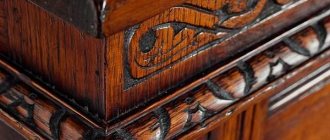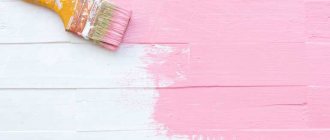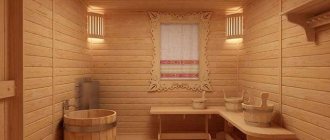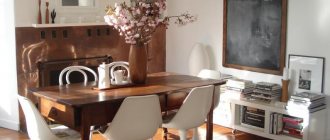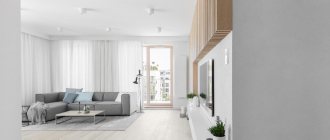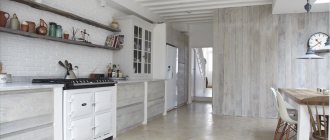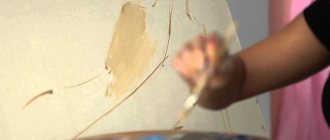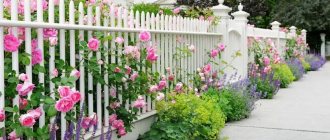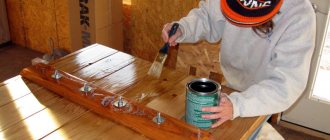Types and features of lining
Nowadays, lining is often used for interior work. But decorating the space is done with different types of materials. They are:
- Quarter paneling. Each element is equipped with protrusions on the sides, which allows them to be overlapped.
- Simple. It is characterized by the presence of tongue-and-groove fastenings.
- With tongue and groove. The material is intended for mounting on walls and ceilings. It looks like a regular tongue and groove board, only smaller in size. The material is intended primarily for office premises.
- Eurolining. It resembles an edged board. On each side the fragments are processed with high quality. The tongue-and-groove system is used for connection. In the production of such lining, coniferous wood is used. Fungus or mold does not grow on this material, since there is a sample on the back of it that provides air removal.
- "American". This type of lining is characterized by an irregular rectangular shape. There is a groove in the widest part of the fragment, thanks to which you can achieve the effect of laying the parts overlapping.
- “Finka.” All elements have an oval shape.
- Block house. With its help, you can create an imitation of a rounded log from inside the room. To fasten the lining, sheathing is required. The material improves the heat and sound insulation of rooms.
You can use lining in a bathhouse, sauna, living rooms, and in the country. But if you are already tired of the natural color, then you can choose different paint options for decorating the surface. There are also substances that help protect wood and increase its service life.
How is coloring done?
How to paint lining so that the effect is long and impressive? For such an event you will need a set of tools:
- Set of brushes and roller. If possible, then a spray gun.
- Tray. To make it easier to pick up paint.
- Protective and decorative compounds.
- Sandpaper, stiff brush.
- It is better to have a stable stepladder and glasses to protect your eyes.
Using a spray gun allows you to quickly complete the work of painting the lining.
Painting consists of several stages. It is much more difficult when work is carried out on an old coating. Then it becomes necessary to remove the old decorative layer and clean the surface well.
Stage one - preparation
Purchased products are checked for possible damage and deformation. It often happens that materials are purchased that belong to a lower class. They require a long preparation - they are processed with sandpaper, and the cracks are covered with wood putty. If there are dark spots on the surface, then bleaching is performed.
If the material has defects in the form of cracks, they are eliminated using putty
Stage two - primer
It is necessary to cover the front side of the lining with priming compounds. This will reduce the consumption of other solutions, increase adhesion, and will also prevent the elements from being subject to deformation
In this case, special attention is paid to the knots; they are literally impregnated to eliminate the possibility of falling out if drying occurs
The primer improves adhesion when painting lining
Stage three - impregnation
Now protective impregnations are applied. These are fire retardants and antiseptics. Impregnation is carried out over the entire surface. Do not allow unpainted areas to remain
It is important to consider that such products should not have any foreign (pungent) odors or change the color of the wood.
When applying protective impregnation, it is necessary to ensure that no untreated areas are left.
Stage four - coloring
How to paint lining inside a house? This procedure begins only after the material has dried well from previous manipulations. The process is:
- The paint is prepared in advance. The solution must be well placed, because at the bottom there may be sediment, which includes the main components.
- A small part of the composition is poured into the tray if a roller is used. It is better to provide a container for the brush that is easy to carry. Using a spray gun makes the work better, and the paint is poured into a special container.
- It should be taken into account that movements are performed along the fibers of the material. You can’t stay in one place, the coating should be uniform.
- Several layers are applied, this will provide an excellent decorative effect.
To obtain a good decorative effect, the paint should be applied in several layers.
Still, how to cover the lining? This question is quite complex, the answer to it depends on many factors that are calculated purely individually. But it must be taken into account that if the composition is used over large areas, then it must ensure the “breathing” of the material.
Applying varnish
Coating lining with varnish begins with reading the instructions for a specific product. It indicates the recommended conditions of the room in which finishing work is planned to be carried out. A primer layer is first applied. You can use a roller for this, but it is important to fill all the unevenness of the lining. The primer usually takes several hours to dry, depending on the specific brand and manufacturer, and then the wood is treated with an antiseptic. This improves the durability of the surface. After the antiseptic has dried, begin to cover the lining with the composition. Pre-stir it until smooth to prevent the formation of streaks on the surface of the wood. Apply the composition with a tightly packed brush; it is advisable to make the layer not too thick so that it can dry evenly. After the first drying, the varnish layer must be sanded to remove the gloss, and a second final layer must be applied, which should be glossy or matte. Keep in mind that the solution must dry completely before the second application, otherwise there is a possibility of inadequate drying of the coating, which can ultimately lead to the formation of streaks and uneven layers.
Applying varnish
Preparing for painting
Before covering the lining with varnish or acrylic, it should be cleaned of dirt and degreased with an alkali-based solution, and then sanded with a flat pumice stone or a grinding wheel. This will require the following tools:
- sponge and brush to remove dirt from the surface;
- roller, brush or spray for applying restoring and brightening agents.
This operation leads to the loss of all the protective characteristics of the wood. To restore them, treatment with a disinfectant composition is necessary. It will not only protect the wood, but also improve the quality of the varnish coating.
How to paint lining correctly
Using regular oil paint to renew the surface gives it an artificial shine and hides the natural grain of the wood. In addition, such coating is short-lived and will soon require modernization. When using acrylic varnish on wood panels:
- the original pattern is preserved;
- ensures attractive appearance;
- creates lasting protection from moisture and weather changes;
- the service life of the cladding is extended (up to 8-10 years).
Depending on the degree of darkening, you can use the concentration of the solution as prepared or dilute it with water in a 1:1 ratio. To avoid differences in the tone of the coating, it is necessary to apply a test stroke in an inconspicuous place. After this, the paint color is selected.
The recovery procedure consists of step-by-step operations:
- surface cleaning;
- drying wood;
- antiseptic treatment;
- testing and selection of shade;
- applying acrylic paint.
The final finishing with clapboard is quite often used in the repair of balconies and cottages. In order for the cladding to maintain a beautiful natural appearance for a long time, you need to follow the rules for using wood material and know how to lighten it. To ensure high-quality restoration of darkened panels, you should choose the right bleaching method. For this purpose, it is advisable to consult with specialists or read the instructions.
Surface preparation
After choosing which varnish is suitable for covering the lining indoors, you can begin the preparation process, which will prevent negative consequences after applying the composition. Preparation begins with complete cleansing of the work area. To do this, you need to remove foreign objects that may interfere with varnishing, wash the wood from dust and dirt, which can reduce the effectiveness of using the solution. Please keep in mind in advance that five to seven days must pass between cladding and varnishing the lining so that the surface is ready to apply a protective layer. Then you need to do a little testing - apply the product to a small section of the wall to check its effect and color range. Select in advance the tools you will need when painting wooden walls or floors:
- Antiseptic.
- Sandpaper or other units for removing the top layer from the lining.
- Rollers and brushes, preferably tightly packed with bristles (it is recommended to use natural bristles, as hairs are less likely to fall out of it).
- Basin for the roller.
- Varnish.
- Auxiliary materials: ladder, disposable gloves, solvent.
If you are not applying the first coating, but decide to replace the previous one, you must first remove it. You can use regular soda for this. If there are fungal infections on the lining, you must first treat them with an antiseptic. Only after this can the solution be applied. First you need to use sandpaper to sand the surface. This way, applying the coating for the lining on the balcony or outside will be more convenient, due to the fact that the brush will not slide on the wall or floor. After completing the preparation, you need to make sure that the room in which you plan to use the product is clean, and check the smoothness of the surface on which you plan to apply the material.
Preparing the lining
How to properly paint the inside of the lining: technology
To paint lining in “dry” rooms inside the house, you can use any type of paint. Here you simply decide on the requirements for the decorative appearance of the surface. If the lining is dry, it can not be impregnated with protective compounds, or you can choose paint/varnish/wax with appropriate additives. You can paint it only on one side, leaving the back side untreated.
Paint each panel of the lining separately
If the lining will be used in damp or unheated rooms, on a balcony, it must first be thoroughly impregnated with protective compounds on all sides, maybe twice. Only after the impregnation has dried can it be painted, varnished, or, in general, given decorative properties. Another point: when installing the lining on a wall or ceiling, it has to be cut into pieces. Places of cuts in damp rooms must also be coated with the composition. It is not necessary to wait until it dries, but it is necessary to process it.
There is one very important nuance that many amateur decorators overlook. If you want to get a professional-level painting of the lining, you need to process each board separately: sand, paint, dry, and only then assemble the surface from the already painted lining. That is, mount already fully processed boards on the wall or ceiling. Only with this approach will the surface of the lining have the same color from any point.
It’s difficult to paint the entire surface of a clapboard wall well
If you paint an already assembled surface, unpainted areas remain in the grooves and recesses, making it difficult to sand large areas. You definitely won't get a perfectly flat surface. The quality of finishing in this option is not above average. It is permissible to paint a finished surface if you are renewing the paint job. This must be done at different intervals, depending on the operating conditions and the properties of the paintwork material.
Correctly, the painting technology looks like this.
- The lining is checked and sorted. All bent, bent or cracked boards are rejected. They can be used to test color, select color, number of layers, practice technique and painting sequence.
- Boards that have been sorted are sanded until completely smooth. It is most effective to work with a sanding machine, but you can also use a block with sandpaper attached to the surface. Sandpaper grit - 250-280. When grinding, circular movements pass through the face, tenon and groove. The back part of the lining can be left without treatment. It is more convenient to work with a grinding machine
- Apply the composition with a roller or brush. Each type of coating has its own points and features - they are written on the can or in the accompanying instructions. In general, the rules are simple: take a little paint and apply it in single strokes along the entire length of the lining. Then rub thoroughly and shade until a uniform color is obtained.
- Having achieved uniform coloring, leave to dry.
- After drying, sand again if necessary. This step is often necessary when working with opaque paints and varnishes. The first layer of paintwork raises the pile of the wood, which is why it becomes rough in places. This pile is removed by repeated sanding.
- The second layer of paintwork is applied. Drying.
There can be many layers: it depends on the hiding power of the paint and on what effect you want to get. But in any case, one rule remains: there should be little composition on the brush. The exception is impregnation or primer. They are applied with a well-moistened brush, but only those without pigment. When applying pigmented protective compositions, the rules for paints apply - the minimum required amount of the composition is well shaded.
Sometimes, even with careful rubbing of the paint, stains are clearly visible. This is not a bad paint, but the properties of wood: in some places the pores absorb better, in others worse. In order to achieve an even color in this case, the surface is first primed. You can use any wood primer or colorless matte varnish (can be water-based). After drying, the surface is sanded (yep, again) and then the required number of layers of paint are applied. Only in this case, after the first layer of paintwork, grinding is rarely required, and if necessary, then in some places, more often on a tenon or groove.
Watch the video to see how to evenly apply glaze, oil or wax.
If furniture quality painting is required, there are even more layers: first a stain is applied, then two layers of primer. After drying, the surface is sanded until the surface is completely matte, first with grain 280, then 320, after removing the dust, a finishing layer is applied - varnish. An example of such work is in the video.
Types of varnishes
Any varnishes are a transparent or translucent material that is used to coat wood in order to protect it and improve its external aesthetic qualities. Before choosing what varnish to coat the lining inside the house with, you need to compare the advantages and disadvantages of all products of this type.
Photo - shades of varnish for lining
These materials are classified according to their composition, properties and area of use. There are varnishes for interior and exterior use; they differ from each other in some qualities (for example, outdoor coating should be indelible) and smell. Depending on the place of application, coatings are divided into:
- Parquet. Used to cover wood on floors. You can choose any color and properties (glossy, matte surface). The key difference from other products in this series is their high resistance to mechanical stress: friction, walking, etc.
- Furniture. For finishing furniture, special compounds are used that provide long-lasting shine and unchanged color of wood over many years of use. Most of them are made on a wax basis;
- Construction boats. They have an increased coefficient of resistance to moisture, which allows them to be used in shipbuilding. Many craftsmen use such products to decorate utility rooms (bathhouses, garages) or facades of residential buildings;
- Decorative. The widest group. Intended solely for room decoration. This varnish can be glossy or matte. Often indelible with water and with excellent antiseptic properties. It is used for covering walls in residential buildings, utility rooms (loggias, cottages, steam rooms, etc.), and sometimes for finishing facades.
Photo - matte gloss
Varnish is a coating for lining, which, depending on the main components, has not only decorative, but also protective properties. Depending on the composition they are :
- Alkyd;
- Acrylic;
- Nitrovarnishes;
- Oily;
- Epoxy;
- Polyurethane.
Let's look at the features of each group. Alkyd varnishes for coating wooden lining can be used on balconies, hallways, and living rooms. They are universal and have high resistance to external aggressive factors (high humidity, temperature changes). These paints and varnishes penetrate deep into the wooden structure, so they take a very long time to dry - sometimes the hardening time of the coating reaches up to 3 days. Disadvantages also include the high cost of the coating and the likelihood of fire.
Photo - alkyd
Colorless acrylic varnish is the most environmentally friendly option for finishing wooden panels. They preserve and prolong the natural color of the wood, while helping to protect it from fire and rot. But they have low resistance to moisture. For example, if acrylic-based varnish is used in a bathroom or on a balcony, it can harden within 4 days. To speed up this process, it is recommended to use compositions with an increased level of crystallization.
Acrylic varnish for finishing lining is water-based (aqua) and solvent-based. Aqualak (Tikkurila, Pinotex, Poly R and others) has a wider range of uses due to the fact that it does not deform the wood. At the same time, the solvent is more resistant to irritating factors and can even be used to cover the floor.
Transparent nitro varnish has no pronounced odor and dries very quickly; at the same time, its price is almost two times lower than options with an acrylic or alkyd base. It is used for painting eurolining inside and outside the house, but it has a significant drawback. The product contains toxic substances that can cause poisoning. After the mixture dries, they are harmless, but it is not recommended to heat walls with such a coating, and it can only be applied while wearing a protective mask.
Photo - nitro varnish sprayer for lining
Oil varnishes are also called impregnation. They are rarely used independently; they provide primary wood processing. Depending on the oil and resin in the composition, the coating can have different colors: from light brown to dark chocolate. After hardening, they form a hard film on the wall or ceiling that is easy to clean. Further processing is carried out on top of it. Among the advantages: moisture resistance, protection of wood from exposure to UV rays, extension of the durability of the coating. The disadvantages include a high level of fire hazard.
Epoxy varnish can be used to paint walls, ceilings, floors, furniture and other surfaces. It has excellent properties of strength and resistance to high humidity. Thanks to this versatility, it is very popular among professional and home craftsmen. You can choose any colors, it is easy to use and apply, and is very flexible. Among the disadvantages is the relatively high price of the coating - from 3 dollars per square meter (at optimal consumption).
Photo - epoxy varnish for self-leveling floor
Polyurethane matte and glossy varnish is the most popular and affordable option of all listed. It contains synthetic fibers that make the mixture easy to apply and increase the durability of the wood. Depending on your needs, you can choose a varnish like paint to change the shade of the wood, or use a transparent option. It comes in white, brown, dark red, etc.
Photo - polyurethane
Video: varnishing lining
Secrets of decorative wood staining: techniques and tricks
City dwellers want to preserve the natural color of wood as much as possible. For those for whom wood in the house is a boring everyday thing, paint the interior lining in some unusual color. Modern paintwork materials allow you to achieve different effects. For example, textured or brushed lining, but in two colors. This technique is often used in loft style interiors.
Brushed lining in two colors is an excellent choice for decorating walls
The trick is to apply two layers of different colors. The first layer is a dark color, the second is a light or brighter color. After playing with colors and the order of their application, you can create your own version. Watch the video - how to get lining brushed in two colors.
Painting in two colors may not be the same. You can make the recesses a darker color, and only slightly tint the face (front part) or do everything exactly the opposite. The result is a striped wall made of clapboard - the effect of a slatted wall.
Lining processing technology
Protection and painting of the lining is carried out in several stages. The first one is preparation. If the finish is new, then before covering the lining, it is enough to clean its surface from dust with a solution of 5 liters of water and 150 grams. soda After drying, you can apply the first layer.
If there are old coatings, sanding with pumice or sandpaper will be required. It is better to do it with a grinding machine. The goal of this procedure is to create a rough texture that will easily adhere to coatings.
Cleaning walls of old paint with a sander
If thick paints are applied to the lining, they can be removed mechanically (with a hair dryer and spatula, or a grinder) or with special chemical solutions. Both methods do not guarantee a perfect result, but it's worth a try. This option is better than painting the clapboard inside the house directly over the old finish.
The coating may not be removed, but then it should be degreased. It is imperative to remove areas with crumbling paint, air cavities and clean until smooth.
If there are serious defects, such as fallen knots, it is necessary to fill the hole and clean it smooth.
Applying protection
If the coating could not be applied to an uninstalled lining, then the joints should be coated more thoroughly in order to treat as large an area as possible. The composition must be applied in a thin and uniform layer. To do this, you can use either a brush and roller, or mechanical tools. If the protection is applied in several layers, then it is important to dry each of them thoroughly before painting the lining with the next composition.
Coloring
The method of applying the topcoat depends on its type. General rules for carrying out work:
- Use two brushes (wide for the main part, narrow for the joints) or a spray gun;
- Painting begins from the top so that random drops do not spoil the finished surface;
- Go through one section once, in a continuous line;
- Some varnishes and paints are applied in two or three layers, each of them must dry naturally within several days;
- It is better to make several thin layers than one thick layer;
- Only painted finishes should not be exposed to UV rays or sudden temperature changes.
In hard-to-reach places, you can use a foam sponge for painting. It is best to apply the composition to the entire area in a short time. If you need to take a break, the joint should be placed in an inconspicuous area.
Applying paint with a spray gun
For interior decoration of a country house, lining is one of the best options. It does not require complex maintenance, and it is enough to restore the surface once every 7-10 years (depending on the type of coating). If you treat it according to all the rules and taking into account the characteristics of operation, the material will last at least 25 years.
How to properly prepare wood?
Before applying paint and varnish composition to wood, it must be prepared.
Drying the panel
On raw wood, the maximum service life of paint and varnish coatings rarely exceeds 2 years, and more often it is even less than 1 year. Therefore, the lamellas must be kept outdoors or indoors, the humidity of which is more than 15% for up to 30-40 days. It is advisable to avoid direct sunlight, which will lead to uneven drying.
Deep penetration antiseptics significantly speed up drying.
You can check the humidity level like this:
- cut a square of 0.4x0.4 m from polyethylene;
- wrap the panel and secure it tightly with tape;
- maintain in this state for a day in room conditions;
- measure the moisture content of polyethylene from the inside.
An oilcloth that is wet to the touch indicates that the panels have not dried sufficiently.
Processing of lamellas
If materials are category B, then they must be sanded. To do this, use a power tool or regular wood sandpaper. In this case, the last stage should be carried out with finishing fine-grained sandpaper. This is done to level the surface of the lining in the area of knots, various inclusions, and differences.
Tip You can process the wood after attaching it to the wall with a sander or an abrasive nylon brush.
here
Applying primer
The essence of treatment with this composition is the creation of a dense layer on the surface of the wood, which binds dust, eliminates small specks after sanding, and reduces the porosity of the material. Adhesion increases, and paints and varnishes gain stronger adhesion.
An additional advantage will be the fact that after such surface treatment, paint consumption is significantly reduced. Therefore, you can purchase more expensive and high-quality compounds.
The following types of wood primers are used:
- based on epoxy resin;
- based on silicone and acrylic;
- acrylic.
You only need to choose a special composition for interior decoration; for this you need to make sure that the packaging has the appropriate markings.
Main purpose of wood processing
Wall upholstery with clapboard is now common, as the material is completely environmentally friendly. However, it is worth considering that the material consists of wood, which causes its gradual aging. This setting can be prevented by using a protective coating. If you use varnish for lining, you can prevent a number of consequences associated with a number of dangerous factors:
- Increased exposure to direct sunlight on the coating;
- High humidity, which promotes surface contact with water;
- Harmful insects;
- Mechanical breakdowns;
- Growth of microorganisms.
After processing the wood, the coating becomes less susceptible to ignition, which increases the safety of the room. Regardless of what varnish you use to cover the lining on the balcony, the additional coating will create a protective layer that prevents external factors from affecting it. This will prevent premature damage to the surface in the form of scratches, loss of the original color, or rubbing. Is it possible to varnish laminate flooring? Read here. Treated wood looks much neater than without the use of varnish, which is explained by the formation of a transparent glossy layer.
Lining
Materials for interior painting
When selecting the necessary tool, it is necessary to take into account that before painting the surface must be treated with anti-rot compounds. With this in mind, you should stock up on the following materials:
- Coarse sandpaper to clean the surface from dirt and foreign matter. This is especially necessary for lower grade linings, the technical conditions for which require the presence of resin pockets - if they are not cleaned out, the painting will not be of high quality.
- Set of painting tools. In addition to the traditional flat brush, you also need a wool roller, a bucket, and a spray gun/spray gun. For tall rooms, a stepladder may also be required.
- Safety glasses and a gauze bandage - if it is impossible to work in a well-ventilated area.
- For priming and antiseptic treatment, it is better to have a separate set of painting supplies, since it is not known in advance how dissimilar coatings will interact with each other.
Chemical cleaning
The simplest and most reliable way to remove contaminants is to use liquid chemical compounds. They are evenly applied to the surface to be treated according to the instructions, and after a while they are washed off along with the dirt. Highly concentrated preparations contain alkaline components that promote rapid removal of soot from surfaces without damaging the wood structure.
To quickly clean walls and floors, you can use a mop with a telescopic handle.
No less effective in the fight against soot are chemical sponges impregnated with deep penetration substances. They contribute to the quick and safe removal of the smallest particles of soot and soot that have penetrated the wood structure.
The principle of working with sponges is quite simple: holding the sponge with one hand, clean the surface from top to bottom.
Finally, it is recommended to wash the cleaned surface with clean water and wipe dry with a soft cloth. This is done as follows: the floor is covered with film or oilcloth to protect the surface from further contamination.
Next, clean water is poured into the container, to which a detergent composition, for example, for washing dishes, or any other degreasing agent is added. The soot is washed off with smooth movements using a soft sponge.
What varnish to paint the lining on the loggia and balcony
In addition to residential premises, luxury private mansions or city apartments also have non-residential, but often used rooms such as a balcony or loggia. And the processing of wood panels should be given special attention here.
Again, water-based varnishes will be appropriate. Such products are safe for allergy sufferers, children and pets, however, their use only in glazed loggias somewhat limits the possibilities of using the drugs.
For those who are just deciding which varnish is best to cover the lining on the balcony, alkyd varnishes are a good choice. Despite the peculiar pungent odor and the long drying process (up to 3 days), such compositions can be used in any climatic conditions. And after final finishing, a dense water-repellent film is formed on the surface, which also protects the panels from mechanical damage.
Acrylic-based compositions do a good job of finishing walls. As construction experts testify when answering the question of what varnish to coat the lining on the balcony with, the feedback is positive. The product allows you to preserve the natural pattern and texture of natural wood, significantly improving the appearance of the product and providing reliable protection against rotting and fire. The advantages include the ability to choose a luxurious color palette, as well as reasonable prices for the goods.
In the question of what varnish to coat the lining on the balcony with, the answer may be a quick-drying colorless nitro varnish. There is no unpleasant odor, however, the drug contains harmful substances that can cause poisoning. Such products must be applied in a respirator, and after drying, the health threat is neutralized by itself.
Waterproof yacht varnish based on a polyurethane mixture is ideal for work on the balcony and in conditions of high humidity (bathrooms, baths, saunas). The coating dries quickly, does not crack or turn yellow for a long time, withstands sudden temperature changes and moisture, and is resistant to ultraviolet radiation.
Some useful tips
If we are talking about painting the lining inside the house, then it would be useful to read some useful tips that will definitely help during the work.
In order to ensure uniform distribution of color on the surface of the lining, it is necessary to thoroughly mix the paint before work. This can be done using a metal rod or a wooden stick. The main thing is that the material is clean.
In order to be sure that the paint is really chosen correctly, before starting work it is worth making a preliminary touch on the surface. Only after this can the main body of work begin.
The most convenient way to apply paint to the lining is with a brush; this will help paint the surface more evenly.
It is best to paint the lining not with a spray gun or roller, but with an ordinary brush. At the same time, apply paint to the surface evenly.
The primer should be the same color as the paintwork. You can make it this way by adding a bit of paint to it before priming.
If the room is too hot, painting is not recommended. In this case, the paint will dry too quickly. This cannot be allowed. It will not adhere too well to the surface of the wood. When it comes to painting, it is better to create optimal conditions for this process. The room temperature should be between 20 and 25°C.
You need to carefully approach the processing of the ends of the lining. To do this, it is necessary to apply a primer on them in several layers, and also apply a paint coating in several layers.
If there is a lot of paint left on the edges of the can, it needs to be collected using a scraper. If it is not there, then you can use an ordinary sheet of iron folded in half.
The paint must be applied with a brush in several layers. The layers should be thin. It is best if there are three layers on the surface. In this case, the lining will be well saturated with paints and varnishes.
How to paint wood paneling white
Wooden lining is painted in the following order:
- Cleaning the surface from contamination;
- Application of protective compounds;
- Painting the lining.
Surface cleaning
For cleaning you will need cloth sandpaper. Depending on the amount of contamination, coarse or fine grain sandpaper can be used. Shallow holes and scratches are repaired with putty.
Attention! Do not use sharpened objects to clean the surface of wooden products. Sharp edges can damage the unique grain pattern of the wood.
The cleaned surface is treated with a 3% solution of soda ash. Soda treatment is required to remove fat deposits and small dust particles.
Application of a protective composition
To ensure better adhesion and protection from insects, drying oil or a special primer composition is used. The protective layer is applied evenly using a brush with soft hair.
The width of the brush depends on the size of the area being treated. For large volumes, a wide brush is required. For small volumes, use small brushes.
To increase the protective effect, red lead or other types of oxidizing agents are added to the primer.
Advice. To protect the surface of the wooden lining, you must use a plastic or rubber spatula.
Then an antiseptic is applied to the surface of the product. The antiseptic is designed to protect wood from moisture penetration and the spread of fungal diseases.
Factory-made products or home-made compounds are used as an antiseptic.
To make an antiseptic with your own hands, you will need 100 grams of iron sulfate and 10 grams of potassium permanganate. The substances are thoroughly mixed. The resulting mixture is diluted in 20 liters of clean warm water. The prepared composition is applied with a roller or brush.
After the antiseptic has dried, begin painting the surface.
Applying paint
White wooden lining is painted after the primer layer has completely dried. Several types of brushes are used to apply paint. To paint the surface of the lining, brushes 5-10 cm wide with medium-hard bristles are used.
To paint hard-to-reach places, brushes 3-5 cm wide are used. To speed up the process and evenly distribute the layer, use a paint roller coated with fine pile or foam rubber.
The work site should be comfortable, warm and well lit. To protect against harmful fumes, the room must be ventilated.
Stepladders, ladders, and scaffolding are used to paint ceilings and the top of walls. Work at height is carried out using special devices. The products used must be strong and stable. Before work, it is necessary to check the safety equipment for serviceability.
Attention! It is prohibited to work at heights without the use of special devices and safety equipment.
Before painting, white paint from the factory packaging is poured into a convenient, clean container. The container is located near the work site.
Use a piece of clean cloth to remove oil droplets and dry your hands. The rag is periodically moistened in the solvent. White spirit and acetone are used as solvents.
The paint is applied with a brush or roller. Hand movements when moving the tool should be smooth.
The coloring composition is applied from top to bottom. The same place is painted in 2-3 passes in opposite directions.
At the junctions of the lining with surfaces that do not require treatment, use masking tape. Adhesive tape is glued along the entire perimeter of the surface.
After the paint has dried, the tape is carefully removed. Accidental splashes are cleaned with a razor blade. Small stains are removed with a cloth soaked in solvent.
To paint wooden lining white, use compositions of brands MA-015, MA-021 with plant components and GF-023, PF-024 with synthetic additives.
Types of painting materials
How to paint the lining? Answering this question can be quite difficult. The fact is that there are many compositions that differ in their characteristics. Their correct use can transform the room or, conversely, ruin the entire appearance.
Protective compounds
These solutions act as protectors, but can provide a certain decorative effect.
Fire retardants
It is necessary to coat products with such a composition that are located in places where fire may occur. Of course, it is better to impregnate all wooden materials used in finishing work.
Antiseptics
Substances that eliminate the threat of various types of bacteria that contribute to rotting and destruction. This solution is perfect when you want to leave the material unchanged. The composition will protect the product for a long time, so it will not require additional painting.
Antiseptic protects the lining from various bacteria
Lucky
In fact, varnishes are already closer to paint compositions, but they have a good protective function. Painting the lining inside the house can be done with different materials:
Acrylic lacquer. Great for all interior spaces. It can be transparent or translucent. If necessary, the substances can be tinted.
Synthetic materials
This option requires caution. At dachas they cover the rooms that are located at the entrance to the house.
It is quite easy to work with varnish compositions, you just need to take into account that to achieve a better result you need to apply them in several layers.
Varnish allows you to protect the lining from rotting, damage and destruction
Decorative options
Paint for lining is the best way to transform a surface that has already served for a considerable period of time. That is, if over time the product began to darken, cracks appeared in places. In this case, it is best to apply paint. As a result, you can completely renovate the interior of your country house and bring to life ideas that will help with this.
Painting the lining is one of the best protection options, which also performs a decorative function.
How to cover the lining? It should be taken into account that different types of material can be used for work.
Oil paint
It is considered one of the most popular substances. This option has been used for many decades. This is because the solution has excellent characteristics. They consist in the fact that the composition penetrates deep enough into the upper layers of wood, ensuring its long-term preservation. The coating retains its properties for 7-10 years.
Some disadvantages cannot be excluded:
- The material has a rich chemical smell that takes a very long time to dissipate.
- The first point leads to limiting the dyeing time. That is, it is not possible to work in winter, because thorough ventilation is required, which can defrost the entire country house.
- The protective property of paint is fraught with another drawback - the material firmly clogs the pores of the wood, it stops breathing. This means that the microclimate, which is especially valuable when using lining, will be spoiled.
Therefore, this composition is used extremely rarely for interior work.
Acrylate paint
It should be immediately noted that this type is very similar to acrylic compositions, but has a lower price and the necessary characteristics.
This coloring option has the following properties:
There is no unpleasant odor that requires long-term ventilation. The coating is much more elastic, which increases service life. It more successfully withstands aggressive external environments
This is very important, because many country houses are left without heating during the winter. The surface remains breathable, which allows you to maintain exactly the atmosphere that is inherent in wooden structures. The work is done much faster and easier.
Acrylate paint allows you to create an elastic, breathable coating
Of course, such material costs a little more than oil paint, but the result exceeds all expectations.
Acrylate paint for woodwork
Processing lining in a residential area
Let's start with the question of what varnish is best to coat the lining inside the house. Here preference is given to water-based varnishes made of acrylic or polyurethane. In this case, pay attention to the label, which should indicate that the product is suitable for interior work.
Such compositions come in one- and two-component types. The former are easier to use, since no additional procedures are required before application, but they have minimal strength, and the treatment will have to be repeated periodically. Products consisting of a base and a hardener provide maximum protection and are better suited for polishing wooden panels in general, and eurolining in particular.
When deciding what varnish to paint the lining inside the house with, it is necessary to take into account the positive aspects of water-based varnishes:
- fire safety (contains fire retardants);
- environmental friendliness (no toxic substances);
- ease of use (even a beginner can handle it).
Among the negative aspects, the following factors are highlighted: the drying time of the coating is approximately a day, the relatively high price, the need for strict adherence to storage conditions.
When deciding which varnish to paint the lining inside the house, and comparing the pros and cons, designers agree that water-based products are the best option, because the disadvantages are not fatal, and the ability to choose the composition will satisfy the preferences of any client. Thus, semi-matte and matte varnishes are suitable for connoisseurs of native wood texture, and glossy options are ideal for lovers of pompous manifolds.
If we talk about what kind of varnish to coat the lining inside a house by company specifically, then here are several manufacturers:
- Commander offers varnishes for every taste. The range includes options with a matte or semi-matte base, as well as glossy and semi-gloss variations. The positive aspects are that it is harmless and lacks an unpleasant odor, which makes it possible to use the product for finishing in children's and bedrooms. The treated surface is easy to clean and practical to use.
- Finncolor produces a semi-gloss and matte composition for lining in dry rooms. Suitable for walls, but not recommended for floors or furniture. Gives antiseptic and dirt-repellent properties, allows you to slow down the aging process of wood. It is possible to add coloring components.
- Pinotex produces a special line of Interior varnish products for use in residential areas, kitchens, etc. The absence of extraneous aromas, relative cheapness and good mechanical properties (the treated surface looks neat, scratches, chips and other damage are minimal) allow domestic drugs to compete with foreign ones.
- Kompozit produces high-quality varnish products for interior work that are colorless and odorless. The surface dries relatively quickly. The possibility of tinting is provided.
Choosing paint for painting
In most cases, we are talking about painting internal surfaces, and the type of paint is selected accordingly - acrylic, water-based or oil-based (white).
The advantage of acrylic paints is their environmental friendliness and comparative cheapness. Oil paints dry faster, but at the same time they emit a specific odor that is not always acceptable to others. Water-based paint, for all its non-toxicity, is still inferior to the other two types in terms of coating durability. Therefore, the use of a certain type of paint is determined by the specific conditions of its use.
Recently, scuba paints have been actively used for painting linings, previously used mainly for painting ceilings. The advantage of scuba tanks is that, while forming the color of the surface, they also form a dirt-repellent layer. Therefore, caring for the white panels, which were decided to be painted with aqualac, will be much less labor-intensive. The downside of scuba gear is its high cost.


